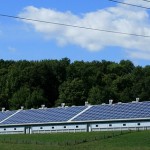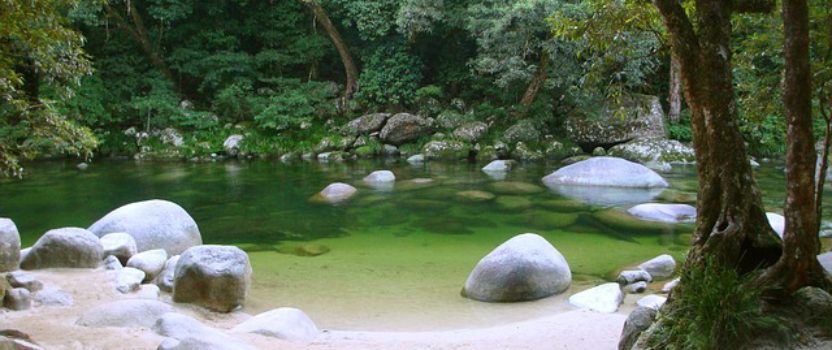Post 6 – Bits About a Lot of Little Ideas
Here I am back again with this week’s post. When I first thought about writing a blog I really believed that three posts a week would be possible but, as always, I underestimated the work involved. This week I have struggled to write one post. It takes time to actually write a post, improve the ‘back end’ of a site, research material for each post as well as experiment with improvements leading towards a low carbon life. In my last post, I optimistically thought I would be able to set up posts in a grid style with pictures on the opening page but no success yet. I have compromised by including a picture of a lovely river and rain-forest to remind me of what is worth preserving.
Trying to live a low carbon life is definitely time-consuming so, for anyone who is making the transition, I really understand. It takes time to identify what needs to be changed, researching how to achieve that change, talking through the impacts of the change with members of your household and then, finally, implementing the change. These time commitments exist outside of the probability that the change itself takes more time on a daily or weekly basis. For example, I gave up using a drier for clothes some years ago. This means that all the washing has to be air-dried which means hanging things out on the clothes line (time-consuming); watching for changes in the weather, which needs some focus, even if it is only in the back of my mind and then possibly making a phone call to ask someone at home to bring in the washing, if I am not there to do so. It also means using indoor clothes racks in inclement weather that need to be moved around the house to follow the sun. All of this takes a lot more time than lifting washing out of the machine and putting it in the drier to set and forget. Is it worth it? Is it necessary? I believe the answers are yes and yes. These small, incremental changes that we make in our lives to reduce emissions accumulate, as we use less and less electricity and we approach the point where our demand may  be such that we only use renewable energy. Some people I talk to, and others whose material I read, believe that it will be possible to simply transition our current lifestyles to one that is powered by renewable energy and battery storage. Others don’t believe this is possible and call it ‘bright siding’ . These people believe that many organisations and people are painting a reassuring, but inaccurate, picture of what our lives will be like when we move to a low carbon or zero net emissions lifestyle. A very easy to listen to energy analyst, Richard Heinberg talks about the concept of ‘intermittency’ where we will have renewable sources of energy and battery storage but we won’t have 24/7 access to power. I certainly don’t know which picture of the future will be correct, maybe neither if we don’t make the necessary changes very soon, but which ever is the case, I am definitely moving to a low carbon life as quickly as I can. I hope I am also ‘future proofing’ myself.
be such that we only use renewable energy. Some people I talk to, and others whose material I read, believe that it will be possible to simply transition our current lifestyles to one that is powered by renewable energy and battery storage. Others don’t believe this is possible and call it ‘bright siding’ . These people believe that many organisations and people are painting a reassuring, but inaccurate, picture of what our lives will be like when we move to a low carbon or zero net emissions lifestyle. A very easy to listen to energy analyst, Richard Heinberg talks about the concept of ‘intermittency’ where we will have renewable sources of energy and battery storage but we won’t have 24/7 access to power. I certainly don’t know which picture of the future will be correct, maybe neither if we don’t make the necessary changes very soon, but which ever is the case, I am definitely moving to a low carbon life as quickly as I can. I hope I am also ‘future proofing’ myself.
At this point, I would like to acknowledge that many of the things I have come to learn about global warming are thanks to a very skilled researcher I know, who has spent a years caring about such matters. When she launches her website, which is a repository for information about climate change, I will provide a link (parked).
As I think about people in my life, the words of two people echo in my head. One is a friend who, a few months ago, when I asked her for her thoughts on climate change, said she thought it was all over and that we had exceeded the ‘tipping point‘ where a series of things happen in the natural world, that we cannot stop and that amplify the rate of global warming.  I hope she is wrong; I think she is wrong and I think the science supports the premise that we are not at the tipping point yet but the frightening possibility is getting closer as we hear more and more about melting ice and other big changes. I notice from my reading that the average rise in the earth’s temperature is already at 0.85 degrees Celsius and keeping it below 2 degrees is the aim. Another measure is the amount of carbon dioxide (‘equivalent’ I think) (parked) that is in the atmosphere. Some groups were pushing to keep it below 350 ppm (parts per million) but, as far as I can tell, we are at 400 ppm already. From reading about the amount of carbon dioxide equivalent in the atmosphere, I learnt about the distinction between emissions and the atmospheric ppm measure. Not all of our emissions end up in the atmosphere. There are naturally occurring carbon ‘sinks’ in the world such as the oceans, forests and soils as well as the atmosphere. Logic tells me that we have to protect the capacity of these sinks to absorb emissions.
I hope she is wrong; I think she is wrong and I think the science supports the premise that we are not at the tipping point yet but the frightening possibility is getting closer as we hear more and more about melting ice and other big changes. I notice from my reading that the average rise in the earth’s temperature is already at 0.85 degrees Celsius and keeping it below 2 degrees is the aim. Another measure is the amount of carbon dioxide (‘equivalent’ I think) (parked) that is in the atmosphere. Some groups were pushing to keep it below 350 ppm (parts per million) but, as far as I can tell, we are at 400 ppm already. From reading about the amount of carbon dioxide equivalent in the atmosphere, I learnt about the distinction between emissions and the atmospheric ppm measure. Not all of our emissions end up in the atmosphere. There are naturally occurring carbon ‘sinks’ in the world such as the oceans, forests and soils as well as the atmosphere. Logic tells me that we have to protect the capacity of these sinks to absorb emissions.
The other person, whose voice echoes in my head, is someone I tried to engage in conversation about climate change leadership. It is something we are desperately in need of, as far as I can tell, and I thought this person might also be interested in the topic but I was clearly wrong. As the conversation developed, it became an education for me about single use plastics. I felt bemused that the lofty conversation I aspired to ended up being about cling wrap and its equivalents and over the next few weeks I kept thinking about where I went wrong in the conversation. I haven’t found an answer to the question about the direction of the conversation, but I have significantly reduced my use of single use plastics. I hadn’t realized how much I was using and how easy it is to stop. Now it looks like we won’t use more than one 30 m roll of cling wrap for the year; I am no longer covering left over food with cling wrap but rather putting it in square or rectangular plastic boxes which last for ages, are easy to stack in the refrigerator and the opaque ones allow you to see what is waiting to be used or eaten. Additionally, we are never buying bottled drinks or any foods that are on non-recyclable plastics or foams. Maybe, once in a while, we won’t be perfect about these choices but we are getting to be pretty good. My trusty reusable water bottle is filled with tap water whenever I leave the house for more than a couple of hours and throughout the day, I drink tap water with a spring of home-grown mint in it. These are all simple, inexpensive probably money-saving initiatives that we can all take that step by step take us towards a low carbon life.

